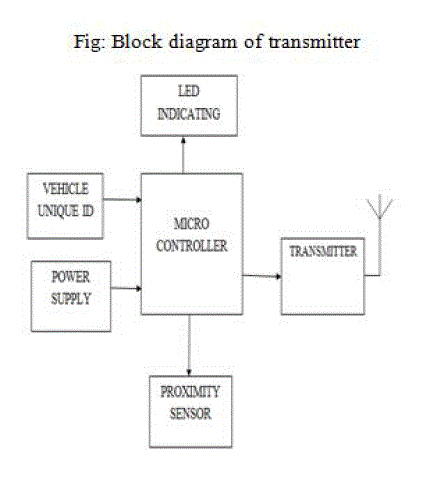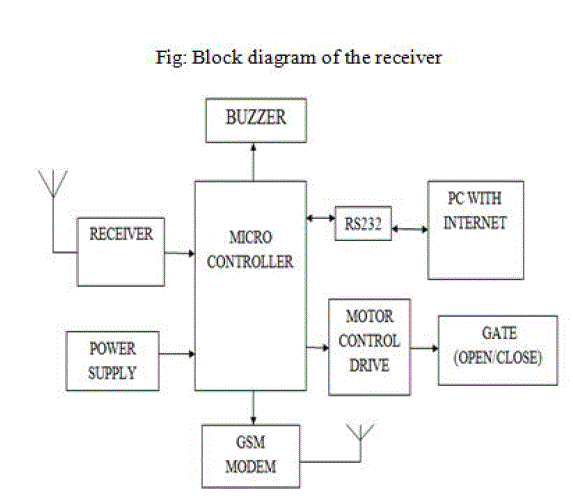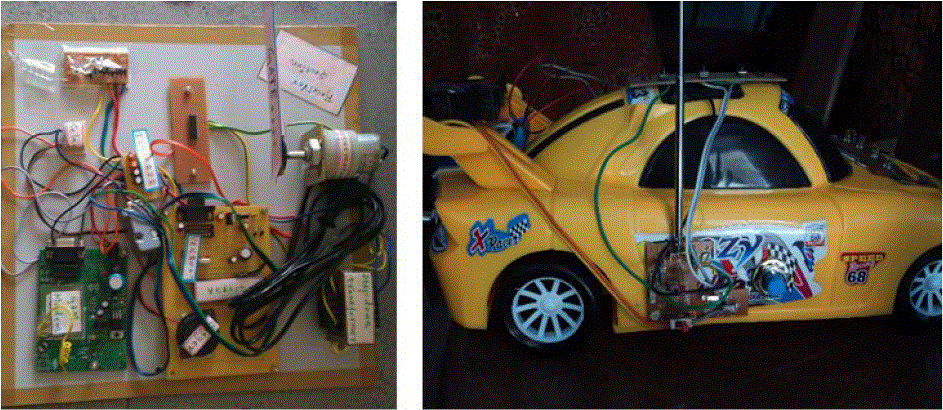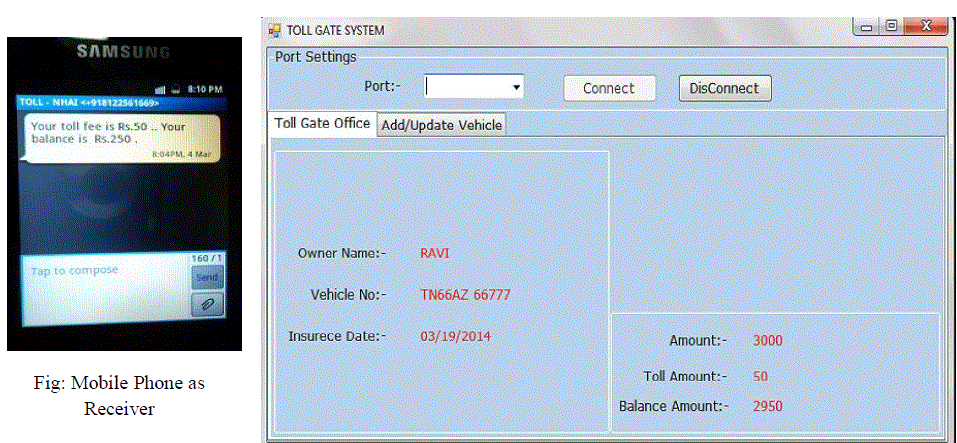Keywords
|
| Auto payment, Vehicle unique id, Zigbee, Smart system. |
INTRODUCTION
|
| Generally Automation in Embedded Systems plays major role in various applications. The main function is to make the system compatible with all devices that can be connected to digital communication networks. Automation reduces human effort and saves lot of time. This paper is based on Automation in Tollgates which mainly uses GSM to transmit the status of the user about his account details via message. It also tracks theft vehicles and unregistered vehicles if the stolen unique ID is uploaded in the centralized server. |
LITERATURE SURVEY
|
| The paper [1] describes that a Radio Frequency on (RFID) is an auto identification technology which uses Radio Frequencies to identify objects remotely that proposes a system which does the job of detecting, billing and accounting for vehicles as they pass through a tollgate using RFID. It reduces the common hustles in accounting for the movement of goods from point to point. The design can be further developed to aid the satellite surveillance systems once all toll gates are networked. An RFID tag is programmed with information in the form of an Electronic Product Code (EPC), which can be read over a considerable distance so that its contents identify the vehicle and enhance a transaction to undertaken with respect to the specific tag identity taking advantage of radio frequencies’ ability to travel longer ranges with better data capacities and high speed attained with maximum accuracy. |
| This paper [2] deals with an improved form of tollgate billing system. An efficient utilization of communication link between RF Modems over a wireless channel to facilitate vehicle monitoring, vehicle authentication and automated toll collection on the highways is proposed. The system is implemented to automatically register vehicles getting on or off a motorway or highway, cutting the amount of time for paying toll in large queues. In this we are using active RFID tag. Mainly concentrate on the security of the vehicle and authentication process whether the driver is correct person or not to use the vehicle. . In this paper we are proposing 3 solutions for authentication of vehicle. They are GSM technology, Using finger prints, Password through passive RFID technology. In this system, the vehicle module consists of an RFID tag and finger print recognizer and the base module consists of RF modem and base server. |
| On comparison, all the above system stresses the use of RFID codes. These codes may not be detected during bad weather conditions. These codes have to be placed out of the car only always. If it is placed inside the vehicle then the code will not be detected. It suffers serious radio interference problems. Radio frequency identification systems tag items with small antennas and electronics, allowing nearby readers to track their movements via radio waves. These RFID systems are especially useful for quick identification of the contents of a shipping pallet, inventory on a shelf in a warehouse, and for secure checkout. While the technology has many benefits, industry groups and suppliers of competing technologies have highlighted some disadvantages, and are working to develop alternatives that address these issues. Other technologies are often better suited for specific applications. Active RFID tags contain a chip and a power source while passive tags get their power from the scanner radio waves and are less costly. Both are more expensive than bar codes. The cost is justified if sensors have to read hidden or obscured tags, but for tags that are in line-of-sight for readers, bar codes and image ID are much less expensive alternatives |
| While an RFID tag can encrypt its data that adds to the already high cost. Without encryption, a company's competitors or other unfriendly organizations can read the tags when the material is in transit and obtain sensitive or confidential information. Image ID systems require line-of-sight scanning like bar codes but use non-directional images. Each image encodes a unique ID that the system uses to call up individual product data from a database. Without access to the database, the ID has no sensitive information and the data remains secure. When manufacturers insert RFID tags in products, the tag is often integrated permanently. After a sale, the tag continues to carry its ID. Consumers who purchase such a product run the risk of being tracked. Stores or other organizations could theoretically place RFID readers at their entrances and identify visitors and some of their past purchases. Bar-code readers do not have the range to scan at a distance and are more privacy-friendly in that respect. RFID tags have problems common to all radio-frequency transmissions and the tags themselves may cause errors. Metal reflects and blocks radio waves, and some frequencies suffer from interference. More than one tag may reply at one time, causing reception errors. If all tag messages don't get through, the totals for pallets or inventories contain mistakes. Image ID systems don't suffer from the same problems. As long as the scanner can see the images, it can read them. |
PROPOSED MODEL AND ITS MERITS
|
| In heavy traffic areas, the vehicles need to stop for 2 minutes pay their toll fee and move. During bad weather conditions, the driver will find it difficult to use rear mirror for identifying the nearby vehicles. The proposed system provides not only the auto toll system but also updates all the vehicle information and stops the vehicle if the vehicle unique ID is not matched with vehicle details. The system is always connected to a centralized server such that any theft vehicle can be trapped easily if its unique ID is registered. Due to this system the number of employees in toll gate is reduced and no time wastage, theft vehicles are detected and stopped automatically, user is indicated about the nearing vehicles. |
METHODOLOGY
|
| The system ensures the payment of Toll fee is being done automatically using a vehicle unique ID. This ID is provided by RTO at the time of vehicle registration. This ID is fixed in the engine of a vehicle and keeps on transmitting continuously if the engine is started. This system uses ZIGBEE transceiver for transmitting and receiving the vehicle unique ID. Transmitter part is fixed in the vehicle while the receiver is fixed in toll gates or traffic signals or anywhere where the vehicles information needs to be recorded or updated. The receiver fixed in toll gate will receive the vehicle ID and will detect the toll fee and will send a message to the owner of the vehicle about the amount deducted and the remaining balance. If there is no balance then the driver can recharge account there itself. The information about the vehicle is updated and it is shown in the PC. The proximity sensors are fitted in 4 sides of the vehicle such that it indicates the nearing vehicles through LED. This avoids usage of rear mirror during bad weather conditions. |
BLOCK DIAGRAM OF AUTO TOLLGATE SMART SYSTEM AND ITS DESCRIPTION
|
| MICROCONTROLLER: They are destined to play an increasingly important role in revolutionizing various industries and influencing our day to day life more strongly than one can imagine. The microcontroller has been recognized as a general purpose building block for intelligent digital systems. A microcontroller is a complete microprocessor system built on a single IC. Microcontrollers were developed to meet a need for microprocessors to be put into low cost products. Building a complete microprocessor system on a single chip substantially reduces the cost of building simple products, which use the microprocessor's power to implement their function, because the microprocessor is a natural way to implement many products. |
| MAJOR FEATURES OF MICROCONTROLLER PIC 16F877A: 16 Bit CPU optimized for control applications, Extensive Boolean processing (Single - bit Logic) Capabilities, On - Chip Flash Program Memory, On - Chip Data RAM, Bi-directional and Individually Addressable I/O Lines, Multiple 16-Bit Timer/Counters, Full Duplex UART, Multiple Source / Vector / Priority Interrupt Structure, On - Chip Oscillator and Clock circuitry, On - Chip EEPROM, SPI Serial Bus Interface, Watch Dog Timer. |
| ZIGBEE: Zigbee is a wireless network protocol specifically designed for low data rate sensors and control networks as shown in Fig Zigbee is a consortium of software, hardware and services companies that have developed a common standard for wireless, networking of sensors and controllers. While other wireless standards are concerned with exchanging large amounts of data, Zigbee is for devices that have smaller throughout needs. The other driving factors are low cost, high reliability, high security, low battery usage, simplicity and Interoperability with other Zigbee devices. Zigbee transmits the Vehicle unique ID along with an address using serial peripheral interface communication .It operates at 800 MHz at a baud rate 19200 bits/second. Low power required up to 5V. Range: 50m typical (5-500m based on environment). Generally it operates at 2.4Ghz but for regional operation it operates at 800-900Mhz. |
| PROXIMITY SENSORS: A proximity sensor is a sensor able to detect the presence of nearby objects without any physical contact. A proximity sensor often emits an electromagnetic field or a beam of electromagnetic radiation and looks for changes in the field or return signal. The object being sensed is often referred to as the proximity sensor's target. Different proximity sensor targets demand different sensors. For example, a capacitive photoelectric sensor might be suitable for a plastic target; an inductive proximity sensor always requires a metal target. The maximum distance that this sensor can detect is defined "nominal range". Some sensors have adjustments of the nominal range or means to report a graduated detection distance. Proximity sensors can have a high reliability and long functional life because of the absence of mechanical parts and lack of physical contact between sensor and the sensed object. |
| ICMAX232: ICMAX232 is used for serial communication between micro controller & PC. It is a 16 pin IC. It operates at a very low voltage. RS232 serial is used to communicate external hardware like microprocessors and micro controllers with computer. Serial RS-232 communication works with voltages (between -15V ... -3V are used to transmit a binary '1' and +3V ... +15V to transmit a binary '0') .All it does is to convert signal voltage levels. |
| ULN2069: ULN2069 is a motor driver 16 pin IC. It amplifies current from microcontroller and gives the output to servo motor. It operates at a very low voltage of 5V. It has Darlington NPN switches inbuilt in it. We can’t drive motor directly from microcontroller, so we use this IC. It interfaces devices to high current & high voltage loads. The buzzers & motors are operated through this IC. |
| GSM MODULE: GSM is global system for mobile communication which is a wireless technology it uses SIM card which is the key feature of GSM. This module consists of a SIM card from which the messages will be sent to the users. |
RESULTS AND DISCUSSION
|
| This project is based on microcontroller programming. The program is written in Embedded C language and is converted into Hex file which is loaded into the microcontroller through Win PIC flash programmer. After compiling program in μcontroller flash compiler, it is loaded into PIC 16F877A microcontroller with the help of universal program burner kit FP8903 programmer which is connected to computer. After successful program burning, microcontroller becomes ready for use. In testing, after successful program loading, microcontroller is mounted on its base and hardware becomes ready for testing. If any vehicle passes through the toll gate, its toll fee is reduced and if any mismatch occurs, the vehicle is not allowed to pass. The amount deducted as a toll fee is intimated to the user as follows. Even the insurance detail of the user is intimated if it’s expired. |
| The receiver side snapshot is shown in the mobile phone. The received information will contain the balance information and the vehicle insurance expiry date. The GUI created using visual basic will keep all the details about the vehicles passed through toll and all information can be updated and stored lifelong. The proximity of the nearing vehicle is sensed and it is indicated to the driver through LED.During snow fall or heavy rainfall the driver need not use the rear mirror for viewing the nearby vehicles. If a vehicle comes in the right side, right LED will glow and indicate the driver that a vehicle is coming right side. If a vehicle comes front or back, the front or back proximity sensors will send a signal to microcontroller , the controller will enable the LED to indicate the user. |
CONCLUSION
|
| In national highways, many vehicles need to stop and pay the fee and get their change for toll fee and then proceed. In this busy world no one need to wait even for minutes during their travel. So all these problems are solved using the proposed system. If the insurance of the vehicle is expired, a message is sent to the user about expiry and vehicle is stopped at toll gates. Then the usage of rear mirror if fully controlled by using proximity sensors. The direction of the nearby vehicle is indicated clearly to the driver. |
Figures at a glance
|
 |
 |
 |
 |
 |
| Figure 1 |
Figure 2 |
Figure 3 |
Figure 4 |
Figure 5 |
|
| |
References
|
- Lovemoregunda ,Lee masuka, Reginald gonye, Samson mhlanga and Lungilenyanga, “RFID based automatic tollgate system”, in cie42 proceedings, cape town, south africa © 2012 cie&saiie
- Sagarmuppalla ,G.Rajeshchandra, N.Rajeshbabu, ”tollgate billing and security of vehicle using rfid”, in international journal of mathematics trends and technology- volume3 issue3- 2012.
- S.H.Kulkarni, A.N.Srivastava, D.Sylvester, “automatic vehicle register system for highway”, in international journal of computer applications, in volume 8, august 2011.
- K.Keutzer, “automatic accident alerter& proximity detector“, international journal of electronic markets, in volume11, november 2012.
- Soon, T.J. 2004, “EPC: Electronic Product Code - The new generation RFID-based product identification system”, Synthesis Journal 2004, Available at: http://www.itsc.org.sg/pdf/Journal%202004/Section_Three_04/Three_Water_2a.pdf, Accessed on: 15/06/12.
- G Ding and Z.Sahinoglu and B.Bhargava and P.Orlik and J Zhang published “Reliable Broad cast en Zigbee networks”, Proc. of IEEE conference on Zigbee.
- U Mohammad published “Performance Evaluation of IEEE 802.15.4 Protocol for Automotive application” in IEEE Manuals. BIOGRAPHY Mr.
|